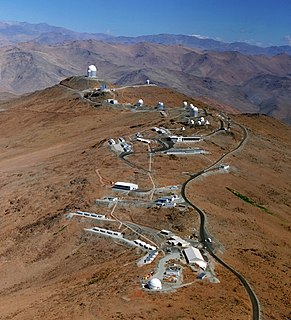Eric Walter Elst is a Belgian astronomer at the Royal Observatory of Belgium in Uccle and a prolific discoverer of asteroids. The Minor Planet Center ranks him among the top 10 discoverers of minor planets with thousands of discoveries made at ESO's La Silla Observatory in northern Chile and at the Rozhen Observatory in Bulgaria during 1986–2009.

Hans-Emil Schuster is a German astronomer and a discoverer of minor planets and comets, who retired in October 1991. He worked at Hamburg Observatory at Bergedorf and European Southern Observatory (ESO), and was former acting director of La Silla Observatory. Since 1982, he was married to Rosemarie Schuster née von Holt

The New Technology Telescope or NTT is an Alt-Az, 3.58-metre Ritchey–Chrétien telescope part of the European Southern Observatory and began operations in 1989. It is located in Chile at the La Silla Observatory and was an early pioneer in the use of active optics. The telescope and its enclosure developed a revolutionary design for optimal image quality.
The Uppsala–ESO Survey of Asteroids and Comets (UESAC) took place in 1992–1993. A large number of asteroids were investigated. Over 15,000 positions were detected, and orbits were calculated for 2500.
Vincenzo Zappalà is an Italian astronomer and discoverer of several main-belt asteroids.
Hans Scholl is a German astronomer, who worked at the Astronomisches Rechen-Institut in Heidelberg, Germany, and at the Côte d'Azur Observatory in Nice, France. In 1999, he was part of a team that discovered three moons of Uranus: Prospero, Setebos and Stephano. He has also co-discoverered 55 minor planets together with Italian astronomer Andrea Boattini at ESO's La Silla Observatory site in northern Chile during 2003–2005.
Giovanni de Sanctis is an Italian astronomer and discoverer of minor planets at the Osservatorio Astronomico di Torino in Turin, Italy. His name is sometimes spelt DeSanctis, particularly in the Minor Planet Circulars. The Minor Planet Center credits him with the discovery of 42 numbered minor planets, most of which he discovered at ESO's La Silla site in northern Chile in the early 1980s.
The Uppsala–DLR Trojan Survey is an astronomical survey to study the movements and locations of asteroids near Jupiter, which includes Jupiter trojans and other asteroids, which line-of sight are frequently blocked by the giant planet.
Isadore Epstein was an astronomer. Epstein taught astronomy at Columbia University for 37 years. He completed his Ph.D. at Princeton University, following which he was appointed as an instructor at Columbia in 1950, assistant professor in 1953, associate professor in 1957, and professor in 1971. He was named professor emeritus in 1987. He served as acting departmental chairman in 1959.
3268 De Sanctis, provisional designation 1981 DD, is a Vestian asteroid from the inner regions of the asteroid belt, approximately 6 kilometers in diameter. It was discovered on 26 February 1981, by European astronomers Henri Debehogne and Giovanni de Sanctis at ESO's La Silla Observatory in northern Chile. The asteroid was named after the second discoverer. The assumed S-type asteroid has a rotation period of 17 hours.
4501 Eurypylos, provisional designation 1989 CJ3, is a Jupiter trojan from the Greek camp, approximately 46 kilometers (29 miles) in diameter. It was discovered on 4 February 1989 by Belgian astronomer Eric Elst at ESO's La Silla Observatory in Chile. The dark Jovian asteroid has a short rotation period of 6.1 hours. It was named after the Thessalian king Eurypylus from Greek mythology.
2187 La Silla, provisionally designated 1976 UH, is a stony Eunomia asteroid from the middle region of the asteroid belt, approximately 12 kilometers in diameter.
22740 Rayleigh, provisional designation 1998 SX146, is a Zhongguo asteroid from the outermost region of the asteroid belt, approximately 10 kilometers (6 miles) in diameter. It was discovered on 20 September 1998, by Belgian astronomer Eric Elst at the La Silla Observatory in Chile. It is one of few asteroids located in the 2 : 1 resonance with Jupiter. The asteroid was named for English physicist and Nobel laureate Lord Rayleigh.
9641 Demazière, provisional designation 1994 PB30, is a stony asteroid from the inner regions of the asteroid belt, approximately 3 kilometers in diameter. It was discovered by Belgian astronomer Eric Elst at ESO's La Silla Observatory site in northern Chile on 12 August 1994. The asteroid was named for Belgian scientist Martine De Mazière.
2590 Mourão, provisional designation 1980 kJ, is a bright Vestian asteroid from the inner regions of the asteroid belt, approximately 7 kilometers in diameter. It was discovered on 22 May 1980, by Belgian astronomer Henri Debehogne at ESO's La Silla Observatory in northern Chile. The V-type asteroid has a rotation period of 15.6 hours. It was named after Brazilian astronomer Ronaldo Rogério de Freitas Mourão.
6117 Brevardastro, provisional designation 1985 CZ1, is a stony asteroid from the inner regions of the asteroid belt, approximately 5 kilometers in diameter.
16560 Daitor, provisional designation 1991 VZ5, is a larger Jupiter trojan from the Trojan camp, approximately 44 kilometers (27 miles) in diameter. It was discovered on 2 November 1991, by Belgian astronomer Eric Elst at the La Silla site of the European Southern Observatory in Chile. The carbonaceous C-type asteroid is one of the largest Jupiter trojans with an unknown rotation period. It was named after the Trojan warrior Daitor from Greek mythology.
Thierry Pauwels is a Belgian astronomer from the Royal Observatory of Belgium. Between 1996 and 2008 he discovered and co-discovered 146 minor planets. This makes him one of the top 100 minor planet discoverers.
2010 TJ is a trans-Neptunian object from the scattered disc in the outermost region of the Solar System and measures approximately 460 kilometers in diameter. It was first observed by American astronomers David Rabinowitz, Megan Schwamb, and Suzanne Tourtellotte at ESO's La Silla Observatory in northern Chile on 2 October 2010.



